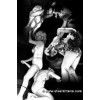Women in wrestling have a long and rich tradition. In ancient Greece and Rome, women wrestled each other, while in some ancient African tribes, women wrestled against both women and men. In the South Pacific, almost 1,000 years ago, women and men alike wrestled and engaged in other martial arts as part of their spiritual and ritual practices. Women were wrestling in Europe at least 150 years ago, but there focus has become slightly more about costume and spectacle. By the time women in wrestling were gaining popularity and attention in America in the early 1900s, the focus was almost always entertainment as opposed to female combat and athleticism.
Over the last century, women’s wrestling as a sport and as entertainment have both developed, sometimes growing apart and other times coming together. At the extreme end of the exploitation and spectacle of women in wrestling were organizations like Women of Wrestling (WOW) and Gorgeous Ladies of Wrestling (GLOW). Somewhere in the middle are the federations like WWF/WWE that showcase very talented female athletes, but do tend to relegate them to second class status and sex symbols much of the time while the men take the limelight. At the other end of the spectrum are the high school, college, and amateur, and professional venues that are giving increasing support and attention to women’s wrestling as a competitive sport.
There is a complex history of legal issues revolving around women in wrestling. Starting at the high school level, where girls wanted to be afforded the equal right to train and compete, there were significant concerns--some of which became lawsuits and controversies. For some time, the dominant paradigm seemed to be that if a woman could try out for a wrestling team and face off against men competitively, then she could be a team member.
The problems here were immediately obvious. Many schools required their male wrestlers to forfeit to women when they came up against them in tournaments. In some cases, religious groups or parents would demand this of boys, even if their schools did not. There was a scandal in 1996 when the Texas Wrestling Officials Association decided they would disband entirely rather than officiate coed matches. No serious athletes, male or female, wanted this contention to detract from their sport.
The obvious conclusion was for schools at the high school and college level to have women’s wrestling programs, but many schools did not think there would be sufficient support or interest. California, Hawaii, and Texas led the way to proving otherwise in the 1990s. The decade started with only a few dozen girls wrestling at the high school level; by the turn of the millennium, Hawaii, Michigan, and Texas had State Championships for high school women in wrestling, and California had countless all-girl squads. Washington soon joined their ranks. Almost 5,000 girls are now wrestling at the high school level, and there are 21 varsity wrestling programs in North American colleges, most of which offer scholarships for their female wrestlers.
Starting in 1987, there were World Championships for women’s wrestling; and, as of 2004, the sport was included in the Olympic Games with four weight classes invited to Athens. Wrestlers from 54 nations attended, 21 of which qualified. The first medal ever awarded in women’s wrestling at the Olympics went to an American--Patricia Miranda.
As women’s competitive wrestling gains popularity, women’s professional wrestling is really changing. Steel Kittens showcases the best professional women in wrestling, combining the amazing athleticism of today’s best female combatants with the exciting showmanship that makes professional wrestling great entertainment as well as an exciting and challenging sport.
Check these three Vintage Classic Womens Wrestling videos below




